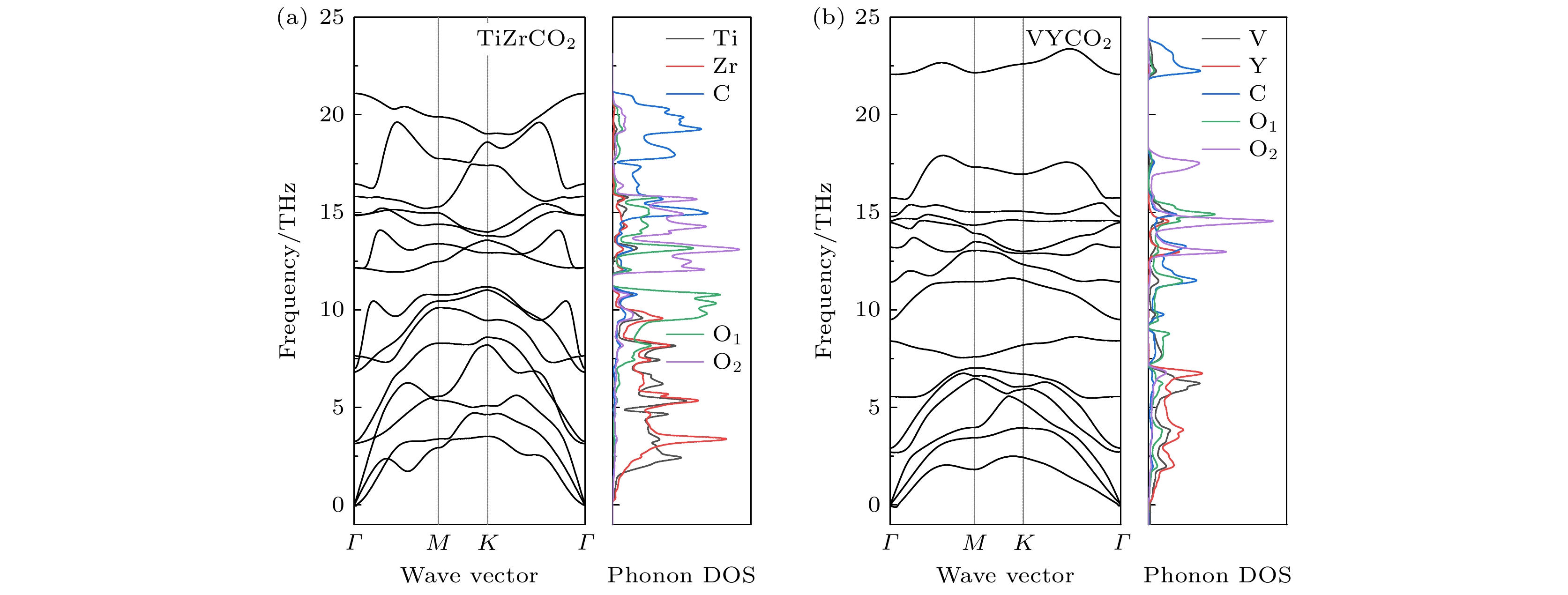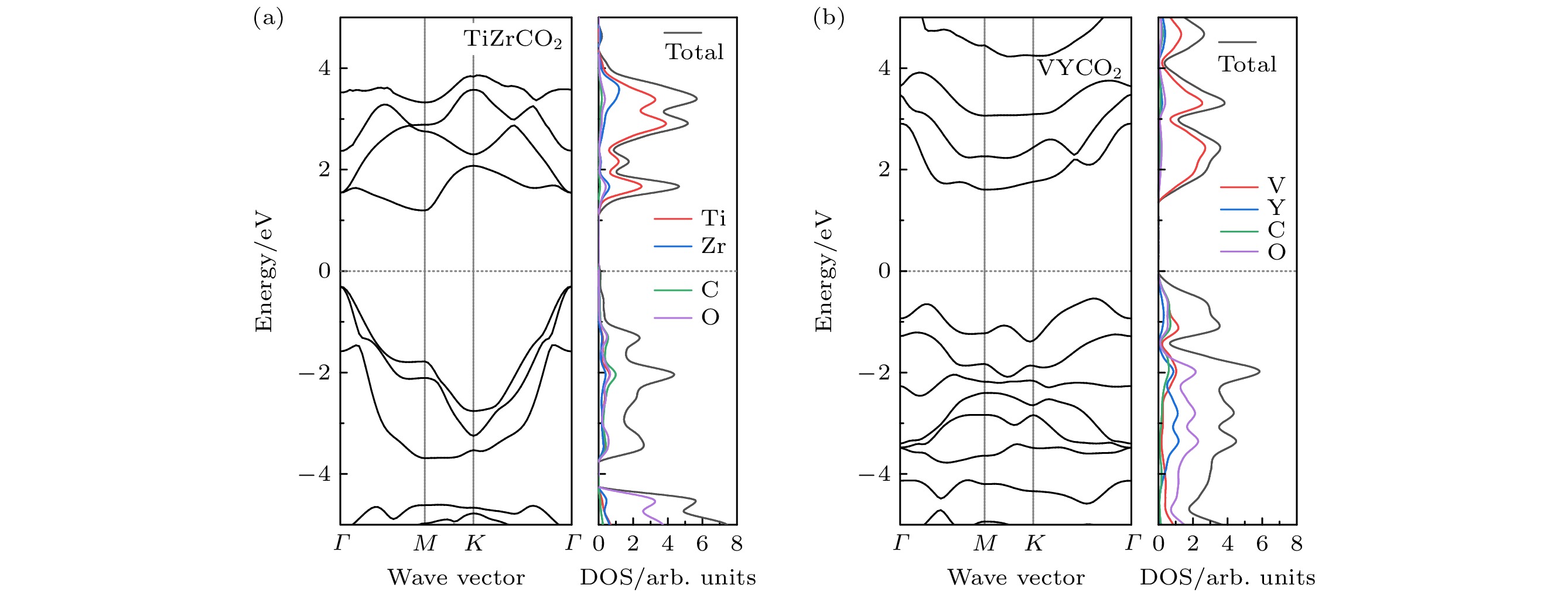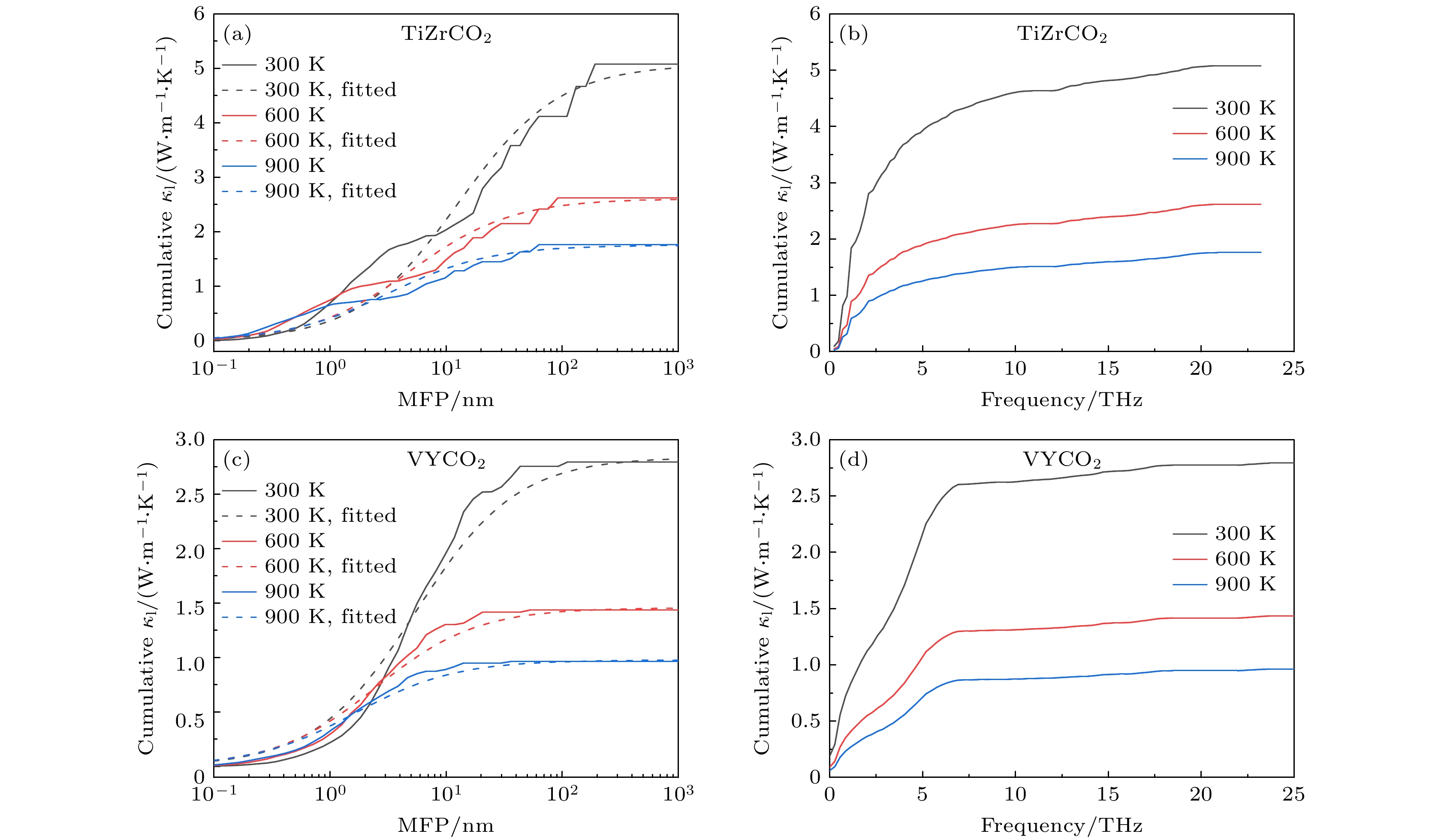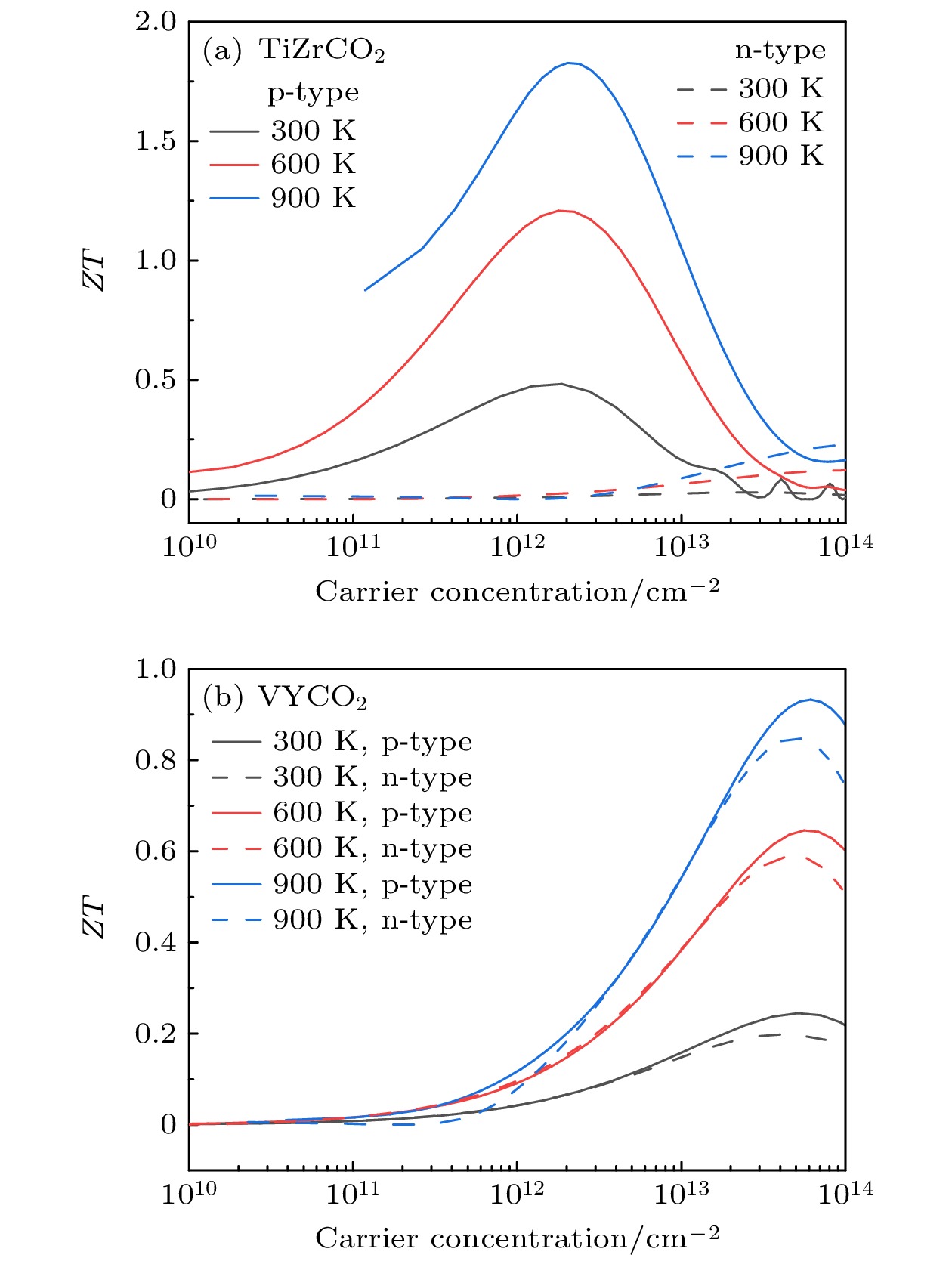-
二维双过渡金属MXene相较于单一过渡金属MXene, 有着更高的可调控性, 在热电器件方面有着潜在的应用. 本文通过第一性原理的计算方法结合玻尔兹曼输运理论, 研究了新型二维双过渡金属MXene单层TiZrCO2和VYCO2的稳定性和热电性能. 结果表明, 两者的热电输运性能优良. 计算预测的结果: 在最优载流子浓度下, 300 K时, p型TiZrCO2功率因子为11.40 mW/(m·K2), 远高于n型, p型VYCO2功率因子 (2.80 mW/(m·K2))和n型(2.20 mW/(m·K2))大小类似. 300 K下, TiZrCO2和VYCO2的晶格热导率较低, 分别为5.08 W/(m·K)和3.22 W/(m·K), 并且随着温度升高进一步降低, 900 K时为2.14 W/(m·K)和1.09 W/(m·K). TiZrCO2和VYCO2的热电优值随温度升高而增大, 温度为900 K时, p型TiZrCO2和VYCO2的热电优值分别达到1.83和0.93, 优于两者n型的0.23和0.84. 双过渡金属MXene TiZrCO2和VYCO2相比单一过渡金属MXene (如Sc2C(OH)2, ZT = 0.5)具有更好的热电性能, 有潜力作为综合性能优良的新型热电材料. 本文采用的一套计算方法亦可为新型双过渡金属元素MXene热电性能探索提供一定借鉴.
-
关键词:
- 双过渡金属MXene /
- 第一性原理 /
- 热电性能 /
- 晶格热导率
The quantum restriction effect of charge carriers in two-dimensional materials can significantly improve their power factors. MXene, as a new type of two-dimensional double transition metal material, has attracted extensive attention due to thermoelectric properties, and higher controllability than single transition metal MXene, which has potential applications in thermoelectric devices. In this work, new two-dimensional monolayer double transition metal MXene, i.e. TiZrCO2 and VYCO2, are designed and their stabilities, electronic and thermoelectric properties are studied by the first principles and Boltzmann transport theory. It has been shown that both are indirect bandgap semiconductors with mechanical, thermodynamic and kinetic stability, and their thermoelectric properties (Seebeck coefficients, electrical and electronic thermal conductivities and lattice thermal conductivities) in a temperature range from 300 K to 900 K are studied. For the optimal carrier concentration at 300 K, the p-type TiZrCO2 power factor is 11.40 mW/(m·K2), much higher than that of n-type one, and the VYCO2 power factor of p-type (2.80 mW/(m·K2)) and n-type (2.20 mW/(m·K2)) are similar to each other. At 300 K, TiZrCO2 and VYCO2 have low lattice thermal conductivities of 5.08 W/(m·K) and 3.22 W/(m·K), respectively, and the contributions of optical phonon to the lattice thermal conductivity are both about 30%, i.e. 2.14 W/(m·K) and 1.09 W/(m·K) at 900 K, respectively. At the same time, it is found that at 300 K, when the material sizes of TiZrCO2 and VYCO2 are within 12.84 nm and 5.47 nm respectively, their lattice thermal conductivities are almost unchanged, and can be adjusted by adjusting the compositions. At 900 K, the thermoelectric value of p-type TiZrCO2 and VYCO2 reach 1.83 and 0.93, respectively, which are better than those of n-type, 0.23 and 0.84. The double transition metals MXene TiZrCO2 and VYCO2 have better thermoelectric properties than the single transition metal MXene (such as Sc2C(OH)2, ZT = 0.5), and have the potential applications in new thermoelectric materials with excellent comprehensive properties. A set of calculation methods used in this paper can also provide some reference for exploring the thermoelectric properties of a new double transition metal element MXene.-
Keywords:
- double transition metal MXene /
- first principles /
- thermoelectric property /
- lattice thermal conductivity
[1] Zhang X, Zhao L D 2015 J. Materiomics 1 92
 Google Scholar
Google Scholar
[2] Snyder G J, Toberer E S 2008 Nat. Mater. 7 105
 Google Scholar
Google Scholar
[3] He J, Tritt T M 2017 Science 357 eaak9997
 Google Scholar
Google Scholar
[4] Rana G, Gupta R, Bera C 2023 Appl. Phys. Lett. 122 063902
 Google Scholar
Google Scholar
[5] Xie W J, Tang X F, Yan Y G, Zhang Q J, Tritt T M 2009 Appl. Phys. Lett. 94 102111
 Google Scholar
Google Scholar
[6] Heremans J P, Jovovic V, Toberer E S, et al. 2008 Science 321 554
 Google Scholar
Google Scholar
[7] Joshi G, Lee H, Lan Y C, Wang X W, Zhu G H, Wang D Z, Gould R W, Cuff D C, Tang M Y, Dresselhaus M S, Chen G, Ren Z F 2008 Nano Lett. 8 4670
 Google Scholar
Google Scholar
[8] Chen X X, Wu H J, Cui J, Xiao Y, Zhang Y, He J Q, Chen Y, Cao J, Cai W, Pennycook S J, Liu Z H, Zhao L D, Sui J H 2018 Nano Energy 52 246
 Google Scholar
Google Scholar
[9] Ruleova P, Drasar C, Lostak P, Li C P, Ballikaya S, Uher C 2010 Mater. Chem. Phys. 119 299
 Google Scholar
Google Scholar
[10] Zhao L D, He J Q, Berardan D, Lin Y, Li J F, Nan C W, Dragoe N 2014 Energ. Environ. Sci. 7 2900
 Google Scholar
Google Scholar
[11] Hicks L D, Dresselhaus M S 1993 Phys. Rev. B 47 12727
 Google Scholar
Google Scholar
[12] Ramanathan A A, Khalifeh J M 2018 IEEE Trans. Nanotechnol. 17 974
 Google Scholar
Google Scholar
[13] Li M L, Wang N, Jiang M, Xiao H Y, Zhang H B, Liu Z J, Zu X T, Qiao L 2019 J. Mater. Chem. C 7 11029
 Google Scholar
Google Scholar
[14] Feng A H, Yu Y, Wang Y, Jiang F, Yu Y, Mi L, Song L X 2017 Mater. Design 114 161
 Google Scholar
Google Scholar
[15] Khazaei M, Ranjbar A, Arai M, Yunoki S 2016 Phys. Rev. B 94 125152
 Google Scholar
Google Scholar
[16] 王剑, 周榆力 2020 西华大学学报(自然科学版) 39 76
 Google Scholar
Google Scholar
Wang J, Zhou Y L 2020 J. Xihua Univ. (Natural Science Edition) 39 76
 Google Scholar
Google Scholar
[17] Kumar S, Schwingenschlögl U T 2016 Phys. Rev. B 94 035405
 Google Scholar
Google Scholar
[18] Gandi A N, Alshareef H N, Schwingenschlögl U 2016 Chem. Mater. 28 1647
 Google Scholar
Google Scholar
[19] Anasori B, Xie Y, Beidaghi M, Lu J, Hosler B C, Hultman L, Kent P R, Gogotsi Y, Barsoum M W 2015 Acs Nano 9 9507
 Google Scholar
Google Scholar
[20] Jing Z A, Wang H Y, Feng X H, Xiao B, Ding Y C, Wu K, Cheng Y H 2019 J. Phys. Chem. Lett. 10 5721
 Google Scholar
Google Scholar
[21] Kim H, Anasori B, Gogotsi Y, Alshareef H N 2017 Chem. Mater. 29 6472
 Google Scholar
Google Scholar
[22] Karmakar S, Saha-Dasgupta T 2020 Phys. Rev. Mater. 4 124007
 Google Scholar
Google Scholar
[23] Chang W L, Sun Z Q, Zhang Z M, Wei X P, Tao X 2023 J. Phys. Chem. Solids 176 111210
 Google Scholar
Google Scholar
[24] Xiong K W, Cheng Z Q, Liu J P, Liu P F, Zi Z F 2023 Rsc Adv. 13 7972
 Google Scholar
Google Scholar
[25] Kresse G, Furthmüller J 1996 Comp. Mater. Sci. 6 15
 Google Scholar
Google Scholar
[26] Perdew J P, Burke K, Ernzerhof M 1996 Phys. Rev. Lett. 77 3865
 Google Scholar
Google Scholar
[27] Kresse G, Joubert D 1999 Phys. Rev. B 59 1758
 Google Scholar
Google Scholar
[28] Heyd J, Scuseria G E, Ernzerhof M 2003 J. Chem. Phys. 118 8207
 Google Scholar
Google Scholar
[29] Madsen G K H, Carrete J, Verstraete M J 2018 Comput. Phys. Commun. 231 140
 Google Scholar
Google Scholar
[30] Bardeen J, Shockley W 1950 Phys. Rev. 80 72
 Google Scholar
Google Scholar
[31] Zhang Y, Maginn E J 2012 J. Phys. Chem. B 116 10036
 Google Scholar
Google Scholar
[32] Togo A, Tanaka I 2015 Scripta Mater. 108 1
 Google Scholar
Google Scholar
[33] Li W, Carrete J, Katcho N A, Mingo N 2014 Comput. Phys. Commun. 185 1747
 Google Scholar
Google Scholar
[34] Born M, Huang K 1955 Am. J. Phys. 23 474
 Google Scholar
Google Scholar
[35] Ouyang B, Chen S D, Jing Y H, Wei T R, Xiong S Y, Donadio D 2018 J. Materiomics 4 329
 Google Scholar
Google Scholar
[36] Madsen G K H, Singh D J 2006 Comput. Phys. Commun. 175 67
 Google Scholar
Google Scholar
[37] Girotto N, Novko D 2023 Phys. Rev. B 107 064310
 Google Scholar
Google Scholar
[38] Xiang J, Ali R N, Yang Y, Zheng Z, Xiang B, Cui X 2019 Physica E 109 248
 Google Scholar
Google Scholar
[39] Sahoo S, Gaur A P, Ahmadi M, Guinel, M J F, Katiyar R S 2013 J. Phys. Chem. C. 117 9042
 Google Scholar
Google Scholar
[40] Wei X P, Shen J, Du L L, Chang W L, Tao X M 2022 Phys. Scripta 97 085706
 Google Scholar
Google Scholar
[41] Zha X H, Yin J, Zhou Y, Huang Q, Luo K, Lang J, Francisco J S, He J, Du S 2016 J. Phys. Chem. C 120 15082
 Google Scholar
Google Scholar
[42] Park T, Cho K, Kim S 2021 Adv. Mater. Technol. 6 2100590
 Google Scholar
Google Scholar
[43] Wu H, Gu J, Li Z, Liu W, Bao H, Lin H, Yue Y 2022 J. Phys. Condens. Matter. 34 155704
 Google Scholar
Google Scholar
[44] Wang L, Liu Q, Zhang Y B 2021 Chin. Phys. B 30 020506
 Google Scholar
Google Scholar
[45] 董文欣, 李铁平, 张莉, 丁迎春, 何开华 2025 原子与分子物理学报 42 046007
 Google Scholar
Google Scholar
Dong W X, Li T P, Zhang L, Ding Y C, He K H 2025 J. At. Mol. Phys. 42 046007
 Google Scholar
Google Scholar
[46] Guo Z L, Miao N H, Zhou J, Pan Y C, Sun Z M 2018 Phys. Chem. Chem. Phy. 20 19689
 Google Scholar
Google Scholar
[47] 刘远超, 关斌, 钟建斌, 徐一帆, 蒋旭浩, 李耑 2023 化工学报 74 3968
 Google Scholar
Google Scholar
Liu C Y, Guan B, Zhong J B, Xu Y F, Jiang X H, Li D 2023 CIESC J. 74 3968
 Google Scholar
Google Scholar
[48] Pang G J, Zhang B, Meng F C, Liu Z, Chen Y, Li W 2023 Phys. Rev. B 108 054303
 Google Scholar
Google Scholar
[49] Schelling P K, Phillpot S R, Keblinski P 2002 Phys. Rev. B 65 144306
 Google Scholar
Google Scholar
-
表 1 单层TiZrCO2 和VYCO2的晶格常数a、弹性张量和带隙
Table 1. Lattice constants a, elastic tensors, and bandgaps of monolayer TiZrCO2 and VYCO2.
a/Å C11(C22)/(N·m–1) C12/(N·m–1) C66/(N·m–1) EPBE/eV EHSE06/eV TiZrCO2 3.19 247.64 87.88 0.01 0.74 1.50 VYCO2 3.32 78.41 38.93 0.20 1.10 2.15 表 2 300 K下单层TiZrCO2 和VYCO2的形变势能E1、弹性常量C、有效质量$m^* $、弛豫时间τ (括号内数据为文献[35]的计算结果)
Table 2. Deformation potential energy E1, elastic constant C, effective mass $m^*$, relaxation time τ of monolayer TiZrCO2 and VYCO2 at 300 K (the data in brackets are the calculation results of Ref. [35]).
Carrier type C/(J·m–2) E1/eV $m^*/m_{\rm e}$ τ/fs TiZrCO2 Electro 248 10.8 2.69 6.39 Hole 248 2.7 0.75 366.56 VYCO2 Electro 78 3.7 1.67 27.48 Hole 78 4.81 0.94 28.96 MoS2 Electro 168(166) 8.34(8.61) 0.46(0.44) 42.51(40.9) Hole 168 3.81 0.56 167.3 -
[1] Zhang X, Zhao L D 2015 J. Materiomics 1 92
 Google Scholar
Google Scholar
[2] Snyder G J, Toberer E S 2008 Nat. Mater. 7 105
 Google Scholar
Google Scholar
[3] He J, Tritt T M 2017 Science 357 eaak9997
 Google Scholar
Google Scholar
[4] Rana G, Gupta R, Bera C 2023 Appl. Phys. Lett. 122 063902
 Google Scholar
Google Scholar
[5] Xie W J, Tang X F, Yan Y G, Zhang Q J, Tritt T M 2009 Appl. Phys. Lett. 94 102111
 Google Scholar
Google Scholar
[6] Heremans J P, Jovovic V, Toberer E S, et al. 2008 Science 321 554
 Google Scholar
Google Scholar
[7] Joshi G, Lee H, Lan Y C, Wang X W, Zhu G H, Wang D Z, Gould R W, Cuff D C, Tang M Y, Dresselhaus M S, Chen G, Ren Z F 2008 Nano Lett. 8 4670
 Google Scholar
Google Scholar
[8] Chen X X, Wu H J, Cui J, Xiao Y, Zhang Y, He J Q, Chen Y, Cao J, Cai W, Pennycook S J, Liu Z H, Zhao L D, Sui J H 2018 Nano Energy 52 246
 Google Scholar
Google Scholar
[9] Ruleova P, Drasar C, Lostak P, Li C P, Ballikaya S, Uher C 2010 Mater. Chem. Phys. 119 299
 Google Scholar
Google Scholar
[10] Zhao L D, He J Q, Berardan D, Lin Y, Li J F, Nan C W, Dragoe N 2014 Energ. Environ. Sci. 7 2900
 Google Scholar
Google Scholar
[11] Hicks L D, Dresselhaus M S 1993 Phys. Rev. B 47 12727
 Google Scholar
Google Scholar
[12] Ramanathan A A, Khalifeh J M 2018 IEEE Trans. Nanotechnol. 17 974
 Google Scholar
Google Scholar
[13] Li M L, Wang N, Jiang M, Xiao H Y, Zhang H B, Liu Z J, Zu X T, Qiao L 2019 J. Mater. Chem. C 7 11029
 Google Scholar
Google Scholar
[14] Feng A H, Yu Y, Wang Y, Jiang F, Yu Y, Mi L, Song L X 2017 Mater. Design 114 161
 Google Scholar
Google Scholar
[15] Khazaei M, Ranjbar A, Arai M, Yunoki S 2016 Phys. Rev. B 94 125152
 Google Scholar
Google Scholar
[16] 王剑, 周榆力 2020 西华大学学报(自然科学版) 39 76
 Google Scholar
Google Scholar
Wang J, Zhou Y L 2020 J. Xihua Univ. (Natural Science Edition) 39 76
 Google Scholar
Google Scholar
[17] Kumar S, Schwingenschlögl U T 2016 Phys. Rev. B 94 035405
 Google Scholar
Google Scholar
[18] Gandi A N, Alshareef H N, Schwingenschlögl U 2016 Chem. Mater. 28 1647
 Google Scholar
Google Scholar
[19] Anasori B, Xie Y, Beidaghi M, Lu J, Hosler B C, Hultman L, Kent P R, Gogotsi Y, Barsoum M W 2015 Acs Nano 9 9507
 Google Scholar
Google Scholar
[20] Jing Z A, Wang H Y, Feng X H, Xiao B, Ding Y C, Wu K, Cheng Y H 2019 J. Phys. Chem. Lett. 10 5721
 Google Scholar
Google Scholar
[21] Kim H, Anasori B, Gogotsi Y, Alshareef H N 2017 Chem. Mater. 29 6472
 Google Scholar
Google Scholar
[22] Karmakar S, Saha-Dasgupta T 2020 Phys. Rev. Mater. 4 124007
 Google Scholar
Google Scholar
[23] Chang W L, Sun Z Q, Zhang Z M, Wei X P, Tao X 2023 J. Phys. Chem. Solids 176 111210
 Google Scholar
Google Scholar
[24] Xiong K W, Cheng Z Q, Liu J P, Liu P F, Zi Z F 2023 Rsc Adv. 13 7972
 Google Scholar
Google Scholar
[25] Kresse G, Furthmüller J 1996 Comp. Mater. Sci. 6 15
 Google Scholar
Google Scholar
[26] Perdew J P, Burke K, Ernzerhof M 1996 Phys. Rev. Lett. 77 3865
 Google Scholar
Google Scholar
[27] Kresse G, Joubert D 1999 Phys. Rev. B 59 1758
 Google Scholar
Google Scholar
[28] Heyd J, Scuseria G E, Ernzerhof M 2003 J. Chem. Phys. 118 8207
 Google Scholar
Google Scholar
[29] Madsen G K H, Carrete J, Verstraete M J 2018 Comput. Phys. Commun. 231 140
 Google Scholar
Google Scholar
[30] Bardeen J, Shockley W 1950 Phys. Rev. 80 72
 Google Scholar
Google Scholar
[31] Zhang Y, Maginn E J 2012 J. Phys. Chem. B 116 10036
 Google Scholar
Google Scholar
[32] Togo A, Tanaka I 2015 Scripta Mater. 108 1
 Google Scholar
Google Scholar
[33] Li W, Carrete J, Katcho N A, Mingo N 2014 Comput. Phys. Commun. 185 1747
 Google Scholar
Google Scholar
[34] Born M, Huang K 1955 Am. J. Phys. 23 474
 Google Scholar
Google Scholar
[35] Ouyang B, Chen S D, Jing Y H, Wei T R, Xiong S Y, Donadio D 2018 J. Materiomics 4 329
 Google Scholar
Google Scholar
[36] Madsen G K H, Singh D J 2006 Comput. Phys. Commun. 175 67
 Google Scholar
Google Scholar
[37] Girotto N, Novko D 2023 Phys. Rev. B 107 064310
 Google Scholar
Google Scholar
[38] Xiang J, Ali R N, Yang Y, Zheng Z, Xiang B, Cui X 2019 Physica E 109 248
 Google Scholar
Google Scholar
[39] Sahoo S, Gaur A P, Ahmadi M, Guinel, M J F, Katiyar R S 2013 J. Phys. Chem. C. 117 9042
 Google Scholar
Google Scholar
[40] Wei X P, Shen J, Du L L, Chang W L, Tao X M 2022 Phys. Scripta 97 085706
 Google Scholar
Google Scholar
[41] Zha X H, Yin J, Zhou Y, Huang Q, Luo K, Lang J, Francisco J S, He J, Du S 2016 J. Phys. Chem. C 120 15082
 Google Scholar
Google Scholar
[42] Park T, Cho K, Kim S 2021 Adv. Mater. Technol. 6 2100590
 Google Scholar
Google Scholar
[43] Wu H, Gu J, Li Z, Liu W, Bao H, Lin H, Yue Y 2022 J. Phys. Condens. Matter. 34 155704
 Google Scholar
Google Scholar
[44] Wang L, Liu Q, Zhang Y B 2021 Chin. Phys. B 30 020506
 Google Scholar
Google Scholar
[45] 董文欣, 李铁平, 张莉, 丁迎春, 何开华 2025 原子与分子物理学报 42 046007
 Google Scholar
Google Scholar
Dong W X, Li T P, Zhang L, Ding Y C, He K H 2025 J. At. Mol. Phys. 42 046007
 Google Scholar
Google Scholar
[46] Guo Z L, Miao N H, Zhou J, Pan Y C, Sun Z M 2018 Phys. Chem. Chem. Phy. 20 19689
 Google Scholar
Google Scholar
[47] 刘远超, 关斌, 钟建斌, 徐一帆, 蒋旭浩, 李耑 2023 化工学报 74 3968
 Google Scholar
Google Scholar
Liu C Y, Guan B, Zhong J B, Xu Y F, Jiang X H, Li D 2023 CIESC J. 74 3968
 Google Scholar
Google Scholar
[48] Pang G J, Zhang B, Meng F C, Liu Z, Chen Y, Li W 2023 Phys. Rev. B 108 054303
 Google Scholar
Google Scholar
[49] Schelling P K, Phillpot S R, Keblinski P 2002 Phys. Rev. B 65 144306
 Google Scholar
Google Scholar
计量
- 文章访问数: 6142
- PDF下载量: 122
- 被引次数: 0














 下载:
下载:








